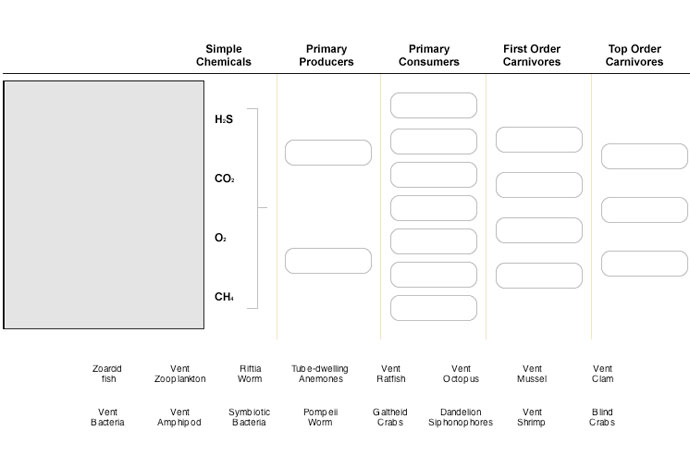Chemosynthetic Food Web
The struggle for food is one of the most important and complex activities to occur in an ecosystem. To help simplify and understand the production and distribution of food within a community, scientists often construct a food web, a diagram that assigns species to generalized, interlinked feeding levels. Each layer of the web represents a particular role in the movement of organic energy through the community.
Despite their unusual nature, faunas based on chemosynthesis are tied together by food webs similar to those of better-known communities. The hydrothermal vent food web below has four layers:
- Primary producers are the original source of food in the vent ecosystem, using chemical energy to create organic molecules. All other life depends on primary producers, and they have the greatest biomass in the community.
- Primary consumers get their energy directly from the primary producers by eating or living symbiotically with them.
- First order carnivores prey on the primary consumers and in turn are eaten by other animals.
- Top order carnivores eat other consumers and carnivores but are rarely hunted by other creatures. Because they are separated from the primary food production by several layers, top order carnivores have the smallest biomass in the food web.
You will reconstruct a hydrothermal vent fauna food web on the diagram below. Click on the image to bring up each animal's photograph and description. Once you have filled in all the spots in the food web, the food web arrows will show you how these animals interact.
Critical Thinking
Marine scientists were stunned to find complex ecosystems based on chemosynthesis flourishing around deep-sea hydrothermal vents. This discovery also caught the attention of space scientists, giving them renewed hope that they might find life elsewhere in the solar system. Explain why chemosynthesis may be more likely to support life on distant worlds than photosynthesis.Scientists seek to understand and explain how the natural world works. Many of the questions raised in this endeavor have no absolute answers.
Although photosynthesis is widespread on Earth, it has fairly stringent requirements. Levels of carbon dioxide, water, and sunlight must be just right, and the temperature can’t be too hot or too cold. Planets closer to the sun than Earth may be too hot, dry, or bright for photosynthesis, while those farther away appear to be too dark and cold. Chemosynthesis is more flexible than photosynthesis. On Earth alone it occurs under a wide temperature range and utilizes a number of different chemicals, and it is unaffected by light intensity. Because chemosynthetic organisms can function in such harsh and hostile habitats on Earth, it seems possible that chemosynthesis may also be occurring under the difficult conditions found on other worlds.
Related Links
Multimedia Discovery Missions: Lesson 5 - Chemosynthesis and Hydrothermal Vent Life


